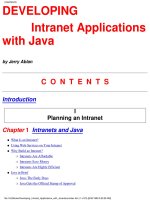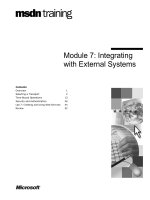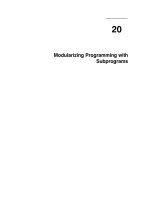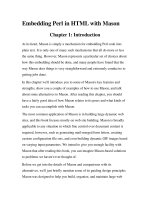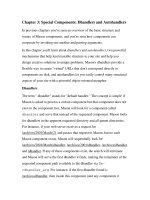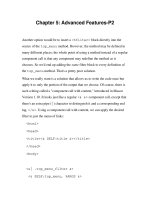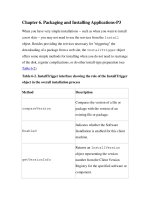Developing with PDF
Bạn đang xem bản rút gọn của tài liệu. Xem và tải ngay bản đầy đủ của tài liệu tại đây (9.32 MB, 217 trang )
www.it-ebooks.info
www.it-ebooks.info
Developing with PDF
Leonard Rosenthol
www.it-ebooks.info
Developing with PDF
by Leonard Rosenthol
Copyright © 2014 Leonard Rosenthol. All rights reserved.
Printed in the United States of America.
Published by O’Reilly Media, Inc., 1005 Gravenstein Highway North, Sebastopol, CA 95472.
O’Reilly books may be purchased for educational, business, or sales promotional use. Online editions are
also available for most titles (). For more information, contact our corporate/
institutional sales department: 800-998-9938 or
Editors: Simon St. Laurent and Meghan Blanchette
Production Editor: Nicole Shelby
Copyeditor: Rachel Head
Indexer: WordCo Indexing Services
October 2013:
Cover Designer: Randy Comer
Interior Designer: David Futato
Illustrator: Rebecca Demarest
First Edition
Revision History for the First Edition:
2013-10-11:
First release
See for release details.
Nutshell Handbook, the Nutshell Handbook logo, and the O’Reilly logo are registered trademarks of O’Reilly
Media, Inc. Developing with PDF, the image of a Chilean Plantcutter, and related trade dress are trademarks
of O’Reilly Media, Inc.
Many of the designations used by manufacturers and sellers to distinguish their products are claimed as
trademarks. Where those designations appear in this book, and O’Reilly Media, Inc., was aware of a trade‐
mark claim, the designations have been printed in caps or initial caps.
While every precaution has been taken in the preparation of this book, the publisher and author assume no
responsibility for errors or omissions, or for damages resulting from the use of the information contained
herein.
ISBN: 978-1-449-32791-0
[LSI]
www.it-ebooks.info
Table of Contents
Preface. . . . . . . . . . . . . . . . . . . . . . . . . . . . . . . . . . . . . . . . . . . . . . . . . . . . . . . . . . . . . . . . . . . . . . . ix
1. PDF Syntax. . . . . . . . . . . . . . . . . . . . . . . . . . . . . . . . . . . . . . . . . . . . . . . . . . . . . . . . . . . . . . . . . 1
PDF Objects
Null Objects
Boolean Objects
Numeric Objects
Name Objects
String Objects
Array Objects
Dictionary Objects
Stream Objects
Direct versus Indirect Objects
File Structure
White-Space
The Four Sections of a PDF
Incremental Update
Linearization
Document Structure
The Catalog Dictionary
The Page Tree
Pages
The Name Dictionary
What’s Next
1
1
2
2
3
4
5
5
7
8
10
13
14
18
20
21
21
24
26
32
33
2. PDF Imaging Model. . . . . . . . . . . . . . . . . . . . . . . . . . . . . . . . . . . . . . . . . . . . . . . . . . . . . . . . . 35
Content Streams
Graphic State
The Painter’s Model
35
36
39
iii
www.it-ebooks.info
Open versus Closed Paths
Clipping
Drawing Paths
Transformations
Basic Color
Marked Content Operators
Property Lists
Resources
External Graphic State
Basic Transparency
What’s Next
39
40
41
42
44
46
47
47
48
49
50
3. Images. . . . . . . . . . . . . . . . . . . . . . . . . . . . . . . . . . . . . . . . . . . . . . . . . . . . . . . . . . . . . . . . . . . 51
Raster Images
Adding the Image
JPEG Images
Transparency and Images
Soft Masks
Stencil Masks
Color-Keyed Masks
Vector Images
Adding the Form XObject
The Form Dictionary
Copying a Page to a Form XObject
What’s Next
51
52
54
55
55
56
57
58
58
59
61
61
4. Text. . . . . . . . . . . . . . . . . . . . . . . . . . . . . . . . . . . . . . . . . . . . . . . . . . . . . . . . . . . . . . . . . . . . . . 63
Fonts
Glyphs
Font Types
The Font Dictionary
Encodings
Text State
Font and Size
Rendering Mode
Drawing Text
Positioning Text
What’s Next
63
63
65
66
69
71
71
73
74
75
76
5. Navigation. . . . . . . . . . . . . . . . . . . . . . . . . . . . . . . . . . . . . . . . . . . . . . . . . . . . . . . . . . . . . . . . 77
Destinations
Explicit Destinations
iv
|
77
77
Table of Contents
www.it-ebooks.info
Named Destinations
Actions
The Action Dictionary
GoTo Actions
URI Actions
GoToR and Launch Actions
Multimedia Actions
Nested Actions
Bookmarks or Outlines
What’s Next
78
79
79
79
80
81
82
82
83
85
6. Annotations. . . . . . . . . . . . . . . . . . . . . . . . . . . . . . . . . . . . . . . . . . . . . . . . . . . . . . . . . . . . . . . 87
Introduction
Annotation Dictionaries
Appearance Streams
Markup Annotations
Text Markup
Drawing Markup
Stamps Markup
Text Annotations and Pop-ups
Non-Markup Annotations
What’s Next
87
87
88
88
89
91
98
101
102
103
7. AcroForms. . . . . . . . . . . . . . . . . . . . . . . . . . . . . . . . . . . . . . . . . . . . . . . . . . . . . . . . . . . . . . . . 105
The Interactive Form Dictionary
The Field Dictionary
Field Names
Field Flags
Fields and Annotations
Field Classes
Button Fields
Text Fields
Choice Fields
Signature Fields
Form Actions
SubmitForm
ResetForm
ImportData
What’s Next
105
106
107
107
108
109
109
112
115
119
119
120
121
122
122
8. Embedded Files. . . . . . . . . . . . . . . . . . . . . . . . . . . . . . . . . . . . . . . . . . . . . . . . . . . . . . . . . . . 123
File Specifications
123
Table of Contents
www.it-ebooks.info
|
v
Embedded File Streams
URL File Specifications
Ways to Embed Files
FileAttachment Annotations
The EmbeddedFiles Name Tree
Collections
The Collection Dictionary
Collection Schema
GoToE Actions
What’s Next
124
125
126
126
127
128
129
130
133
134
9. Multimedia and 3D. . . . . . . . . . . . . . . . . . . . . . . . . . . . . . . . . . . . . . . . . . . . . . . . . . . . . . . . 137
Simple Media
Sound Annotations
Movie Annotations
Multimedia
Screen Annotation
Rendition Actions
3D
3D Annotations
Markups on 3D
What’s Next
137
137
139
141
141
142
145
145
148
149
10. Optional Content. . . . . . . . . . . . . . . . . . . . . . . . . . . . . . . . . . . . . . . . . . . . . . . . . . . . . . . . . . 151
Optional Content Groups
Content State
Usage
Optional Content Membership
Visibility Policies
Visibility Expressions
Optional Content Configuration
Order Key
RBGroups
AS (Automatic State)
Optional Content Properties
Marking Content as Optional
Optional Content in Content Streams
Optional Content for Form XObjects
Optional Content for Annotations
What’s Next
151
151
152
154
154
154
155
156
159
160
160
161
161
164
165
166
11. Tagging and Structure. . . . . . . . . . . . . . . . . . . . . . . . . . . . . . . . . . . . . . . . . . . . . . . . . . . . . 167
vi
|
Table of Contents
www.it-ebooks.info
Structured PDF
The Structure Tree
Structure Elements
Role Mapping
Associating Structure to Content
Tagged PDFs
What’s Next
167
168
169
172
174
175
176
12. Metadata. . . . . . . . . . . . . . . . . . . . . . . . . . . . . . . . . . . . . . . . . . . . . . . . . . . . . . . . . . . . . . . . 177
The Document Information Dictionary
Metadata Streams
XMP
XMP in PDF
XMP versus the Info Dictionary
What’s Next
177
179
179
182
184
184
13. PDF Standards. . . . . . . . . . . . . . . . . . . . . . . . . . . . . . . . . . . . . . . . . . . . . . . . . . . . . . . . . . . . 185
PDF (ISO 32000)
PDF/X (ISO 15930)
PDF/A (ISO 19005)
PDF/E (ISO 24517)
PDF/VT (ISO 16612-2)
PDF/UA (ISO 14289)
Other PDF-Related Standards
PAdES (ETSI TS 102 778)
PDF Healthcare
185
186
187
187
188
188
188
188
189
Index. . . . . . . . . . . . . . . . . . . . . . . . . . . . . . . . . . . . . . . . . . . . . . . . . . . . . . . . . . . . . . . . . . . . . . . 191
Table of Contents
www.it-ebooks.info
|
vii
www.it-ebooks.info
Preface
The Portable Document Format (PDF) is the way in which most documents are pro‐
duced for distribution, collaboration, and archiving worldwide. It has been standardized
by the International Organization for Standardization (ISO) and by governments in
over 75 countries as their format of choice for their documentation. The printing in‐
dustry has required the use of PDF for any professional printing job. With billions of
publicly available documents and an untold number of documents living in private
repositories, no other file format has the wide reach and ubiquity that PDF does.
However, even with those billions of documents in circulation, the PDF format remains
poorly understood by users and developers alike due to there being a dearth of docu‐
mentation beyond ISO 32000-1, the PDF standard itself. And while the standard is an
excellent technical document, its size, complexity, and dry style make it unapproachable
for many.
The goal of this book is to provide an approachable reference to PDF. It covers key topics
from the standard in a way that will enable the technically minded to understand what
is inside a PDF. For those simply needing to examine the internals of a PDF to diagnose
problems, you will find the tools you need here, and those who want to construct their
own valid and well-formed documents will find out how to do so.
Who Should Read This Book
While this book goes into some fairly deep technical topics, I’ve tried to present them
in such a way that any technically minded individual should find the material ap‐
proachable and understandable.
This book is suitable for:
• Users of PDF software, such as Adobe Acrobat, who want to understand what is
going on “under the hood” of the various features in those products (features like
inserting and deleting pages or converting images).
ix
www.it-ebooks.info
• Industry professionals in areas such as electronic publishing and printing who want
to better understand PDF in order to improve their systems, or who need to diag‐
nose issues in their PDF processing.
• Programmers writing code to read, edit, or create PDF files.
Organization of Content
Chapter 1
We begin by looking at the various objects that make up a PDF file and how they
are combined together into a cohesive whole.
Chapter 2
In this chapter we look at the core aspect of PDF—its imaging model. We learn how
to create a page and draw some graphics on it.
Chapter 3
Continuing on from our discussion of the core imaging model, in this chapter we
explore how to incorporate raster images into your PDF content.
Chapter 4
Next, we learn how to incorporate the last of the common types of PDF content—
text. Of course, a discussion of text in PDF wouldn’t be complete without an un‐
derstanding of fonts and glyphs.
Chapter 5
PDF isn’t just about static content. This chapter will introduce various ways in which
a PDF can gain interactivity, specifically around enabling navigation within and
between documents.
Chapter 6
This chapter explores the special objects that are annotations, which are drawn on
top of the regular content to enable everything from interactive links to 3D to video
and audio.
Chapter 7
Next, we look at how interactive forms are provided for in the PDF language.
Chapter 8
This chapter demonstrates how a PDF can be used in a way similar to a ZIP archive
by embedding files inside of it.
Chapter 9
This chapter explains how video and audio content can be referenced in or em‐
bedded into a PDF for playing as part of rich content.
x
|
Preface
www.it-ebooks.info
Chapter 10
This chapter introduces optional content, which only appears at certain times, such
as on the screen but not when printed or only for certain users.
Chapter 11
This chapter looks at how to add semantic richness to your content by tagging it
with HTML-like structures such as paragraphs and tables.
Chapter 12
This chapter explores the various ways in which metadata can be incorporated into
a PDF file, from the simplest document level strings to rich XML attached to indi‐
vidual objects.
Chapter 13
Finally, this chapter introduces the various open international standards based on
PDF, including the full PDF standard itself (ISO 32000-1), the various subsets (such
as PDF/A and PDF/X), as well as related work (such as PAdES).
Conventions Used in This Book
The following typographical conventions are used in this book:
Italic
Indicates new terms, URLs, email addresses, file and path names, and file exten‐
sions.
Constant width
Used for program listings, as well as within paragraphs to refer to program elements
such as variable or function names, operators and operands, HTML elements, and
keys and their values.
This icon signifies a tip, suggestion, or general note.
This icon indicates a warning or caution.
Safari® Books Online
Safari Books Online is an on-demand digital library that delivers
expert content in both book and video form from the world’s lead‐
ing authors in technology and business.
Preface
www.it-ebooks.info
|
xi
Technology professionals, software developers, web designers, and business and crea‐
tive professionals use Safari Books Online as their primary resource for research, prob‐
lem solving, learning, and certification training.
Safari Books Online offers a range of product mixes and pricing programs for organi‐
zations, government agencies, and individuals. Subscribers have access to thousands of
books, training videos, and prepublication manuscripts in one fully searchable database
from publishers like O’Reilly Media, Prentice Hall Professional, Addison-Wesley Pro‐
fessional, Microsoft Press, Sams, Que, Peachpit Press, Focal Press, Cisco Press, John
Wiley & Sons, Syngress, Morgan Kaufmann, IBM Redbooks, Packt, Adobe Press, FT
Press, Apress, Manning, New Riders, McGraw-Hill, Jones & Bartlett, Course Technol‐
ogy, and dozens more. For more information about Safari Books Online, please visit us
online.
How to Contact Us
Please address comments and questions concerning this book to the publisher:
O’Reilly Media, Inc.
1005 Gravenstein Highway North
Sebastopol, CA 95472
800-998-9938 (in the United States or Canada)
707-829-0515 (international or local)
707-829-0104 (fax)
We have a web page for this book, where we list errata, examples, and any additional
information. You can access this page at />To comment or ask technical questions about this book, send email to bookques
For more information about our books, courses, conferences, and news, see our website
at .
Find us on Facebook: />Follow us on Twitter: />Watch us on YouTube: />
xii
|
Preface
www.it-ebooks.info
Acknowledgments
This book wouldn’t exist were it not for the love and support of my ( באַ שערטbashert),
Marla Rosenthol.
Dr. James King and Dr. Matthew Hardy of Adobe Systems and Olaf Drümmer of Callas
Software took time out of their normal jobs to do technical reviews of the material in
this book. Thanks guys!
I would also like to thank my editors, Simon St. Laurent and Meghan Blanchette.
Preface
www.it-ebooks.info
|
xiii
www.it-ebooks.info
CHAPTER 1
PDF Syntax
We’ll begin our exploration of PDF by diving right into the building blocks of the PDF
file format. Using these blocks, you’ll see how a PDF is constructed to lead to the pagebased format that you are familiar with.
PDF Objects
The core part of a PDF file is a collection of “things” that the PDF standard (ISO 32000)
refers to as objects, or sometimes COS objects.
COS stands for Carousel Object System and refers to the original/
code name for Adobe’s Acrobat product.
These aren’t objects in the “object-oriented programming” sense of the word; instead,
they are the building blocks on which PDF stands. There are nine types of objects: null,
Boolean, integer, real, name, string, array, dictionary, and stream.
Let’s look at each of these object types and how they are serialized into a PDF file. From
there, you’ll then see how to take these object types and use them to build higher-level
constructs and the PDF format itself.
Null Objects
The null object, if actually written to a file, is simply the four characters null. It is syn‐
onymous with a missing value, which is why it’s extremely rare to see one in a PDF. If
you have reason to work with the null value, be sure to consult ISO 32000 carefully
about the subtleties involving its handling.
1
www.it-ebooks.info
Boolean Objects
Boolean objects represent the logical values of true and false and are represented ac‐
cordingly in the PDF, either as true or false.
When writing a PDF, you will always use true or false. However, if
you are reading/parsing a PDF and wish to be tolerant, be aware that
poorly written PDFs may use other capatilization forms, including
leading caps (True or False) or all caps (TRUE or FALSE).
Numeric Objects
PDF supports two different types of numeric objects—integer and real—representing
their mathematical equivalents. While older versions of PDF had stated implementation
limits that matched Adobe’s older implementations, those should no longer be taken to
be file format limitations (nor should those of any specific implementation by any ven‐
dor).
While PDF supports 64-bit numbers (so as to enable very large files),
you will find that most PDFs don’t actually need them. However, if you
are reading a PDF, you may indeed encounter them, so be prepared.
Integer numeric objects consist of one or more decimal digits optionally preceded by a
sign, representing a signed value (in base 10). Example 1-1 shows a few examples of
integers.
Example 1-1. Integers
1
-2
+100
612
Real numeric objects consist of one or more decimal digits with an optional sign and a
leading, trailing, or embedded period representing a signed real value. Unlike PostScript,
PDF does not support scientific/exponential format, nor does it support non-decimal
radices.
2
|
Chapter 1: PDF Syntax
www.it-ebooks.info
While the term “real” is used in PDF to represent the object type, the
actual implementation of a given viewer might use double, float, or
even fixed point numbers. Since the implementations may differ, the
number of decimal places of precision may also differ. It is therefore
recommended for reliability and also for file size considerations to not
write more than four decimal places.
Example 1-2 shows some examples of what real numbers look like in PDF.
Example 1-2. Reals
0.05
.25
-3.14159
300.9001
Name Objects
A name object in PDF is a unique sequence of characters (except character code 0, ASCII
null) normally used in situations where there is a fixed set of values. Names are written
into a PDF with a / (SOLIDUS) character followed by a UTF-8 string, with a special
encoding form for any nonregular character. Nonregular characters are those defined
to be outside the range of 0x21 (!) through 0x7E (~), as well as any white-space character
(see Table 1-1). These nonregular characters are encoded starting with a # (NUMBER
SIGN) and then the two-digit hexadecimal code for the character.
Because of their unique nature, most names that you will write into a PDF are predefined in ISO 32000 or will be derived from external data (such as a font or color name).
If you need to create your own nonexternal data-based custom names
(such as a private piece of metadata), you must follow the rules for
second class names as defined in ISO 32000-1:2008, Annex E, if you
wish your file to be considered a valid PDF. A second class name is one
that begins with your four-character ISO-registered prefix followed by
an underscore (_) and then the key name. An example is included at
the end of Example 1-3.
Example 1-3. Names
/Type
/ThisIsName37
/Lime#20Green
/SSCN_SomeSecondClassName
PDF Objects
www.it-ebooks.info
|
3
String Objects
Strings as they are serialized into PDF are simply series of (zero or more) 8-bit bytes
written either as literal characters enclosed in parentheses, ( and ), or hexadecimal data
enclosed in angle brackets (< and >).
A literal string consists of an arbitrary number of 8-bit characters enclosed in paren‐
theses. Because any 8-bit value may appear in the string, the unbalanced parentheses
( ) ) and the backslash (\) are treated specially through the use of the backslash to escape
special values. Additionally, the backslash can be used with the special \ddd notation to
specify other character values.
Literal strings come in a few different varieties:
ASCII
A sequence of bytes containing only ASCII characters
PDFDocEncoded
A sequence of bytes encoded according to the PDFDocEncoding (ISO 32000–
1:2008, 7.9.2.3)
Text
A sequence of bytes encoded as either the PDFDocEncoding or as UTF–16BE (with
the leading byte order marker)
Date
An ASCII string whose format D:YYYYMMDDHHmmSSOHH’mm is described in ISO
32000–1:2008, 7.9.4
Dates, as a type of string, were added to PDF in version 1.1.
A series of hexadecimal digits (0–9, A–F) can be written between angle brackets, which
is useful for including more human-readable arbitrary binary data or Unicode values
(UCS-2 or UCS-4) in a string object. The number of digits must always be even, though
white-space characters may be added between pairs of digits to improve human read‐
ability. Example 1-4 shows a few examples of strings in PDF.
Example 1-4. Strings
(Testing)
(A\053B)
(Français)
<FFFE0040>
(D:19990209153925-08'00')
<1C2D3F>
4
|
%
%
%
%
%
%
ASCII
Same as (A+B)
PDFDocEncoded
Text with leading BOM
Date
Arbitrary binary data
Chapter 1: PDF Syntax
www.it-ebooks.info
The percent sign (%) denotes a comment; any text that follows it is
ignored.
The previous discussion about strings was about how the values are serialized into a
PDF file, not necessarily how they are handled internally by a PDF processor. While
such internal handling is outside the scope of the standard, it is important to remember
that different file serializations can produce the same internal representation (like (A
\053B) and (A+B) in Example 1-4).
Array Objects
An array object is a heterogeneous collection of other objects enclosed in square brackets
([ and ]) and separated by white space. You can mix and match any objects of any type
together in a single array, and PDF takes advantage of this in a variety of places. An
array may also be empty (i.e., contain zero elements).
While an array consists only of a single dimension, it is possible to construct the equiv‐
alent of a multidimensional array. This construct is not used often in PDF, but it does
appear in a few places, such as the Order array in a data structure known as an optional
content group dictionary. (See “Optional Content Groups” on page 151.)
There is no limit to the number of elements in a PDF array. Howev‐
er, if you find an alternative to a large array (such as the page tree for
a single Kids array), it is always better to avoid them for perfor‐
mance reasons.
Some examples of arrays are given in Example 1-5.
Example 1-5. Arrays
[ 0 0 612 792 ]
[ (T) –20.5 (H) 4 (E) ]
[ [ 1 2 3 ] [ 4 5 6 ] ]
% 4-element array of all integers
% 5-element array of strings, reals, and integers
% 2-element array of arrays
Dictionary Objects
As it serves as the basis for almost every higher-level object, the most common object
in PDF is the dictionary object. It is a collection of key/value pairs, also known as an
associative table. Each key is always a name object, but the value may be any other type
of object, including another dictionary or even null.
PDF Objects
www.it-ebooks.info
|
5
When the value is null, it is treated as if the key is not present. There‐
fore, it is better to simply not write the key, to save processing time and
file size.
A dictionary is enclosed in double angle brackets (<< and >>). Within those brackets,
the keys may appear in any order, followed immediately by their values. Which keys
appear in the dictionary will be determined by the definition (in ISO 32000) of the
higher-level object that is being authored.
While many existing implementations tend to write the keys sorted alphabetically, that
is neither required nor expected. In fact, no assumptions should be made about dictio‐
nary processing, either—the keys may be read and processed in any order. A dictionary
that contains the same key twice is invalid, and which value is selected is undefined.
Finally, while it improves human readability to put line breaks between key/value pairs,
that too is not required and only serves to add bytes to the total file size.
There is no limit to the number of key/value pairs in a dictionary.
Example 1-6 shows a few examples.
Example 1-6. Dictionaries
% a more human-readable dictionary
<<
/Type /Page
/Author (Leonard Rosenthol)
/Resources << /Font [ /F1 /F2 ] >>
>>
% a dictionary with all white-space stripped out
<</Length 3112/Subtype/XML/Type/Metadata>>
Name trees
A name tree serves a similar purpose to a dictionary, in that it provides a way to associate
keys with values. However, unlike in a dictionary, the keys are string objects instead of
names and are required to be ordered/sorted according to the standard Unicode colla‐
tion algorithm.
This concept is called a name tree because there is a “root” dictionary (or node) that
refers to one or more child dictionaries/nodes, which themselves can refer to one or
more child dictionaries/nodes, thus creating many branches of a tree-like structure.
6
|
Chapter 1: PDF Syntax
www.it-ebooks.info
The root node holds a single key, either Names (for a simple tree) or Kids (for a more
complex tree). In the case of a complex tree, each of the intermediate nodes will also
have a Kids key present; the final/terminal nodes of each branch will contain the Names
key. It is the array value of the Names key that specifies the keys and their values by
alternating key/value, as shown in Example 1-7.
Example 1-7. Example name trees
% Simple name tree with just some names
1 0 obj
<<
/Names
[
(Apple)
(Orange)
% These are sorted, hence A, N, Z...
(Name 1) 1
% and values can be any type
(Name 2) /Value2
(Zebra) << /A /B >>
]
>>
endobj
Number trees
A number tree is similar to a name tree, except that its keys are integers instead of strings
and are sorted in ascending numerical order. Also, the entries in the leaf (or root) nodes
containing the key/value pairs are found as the value of the Nums key instead of the Names
key.
Stream Objects
Streams in PDF are arbitrary sequences of 8-bit bytes that may be of unlimited length
and can be compressed or encoded. As such, they are the object type used to store large
blobs of data that are in some other standardized format, such as XML grammars, font
files, and image data.
A stream object is represented by the data for the object preceded by a dictionary con‐
taining attributes of the stream and referred to as the stream dictionary. The use of the
words stream (followed by an end-of-line marker) and endstream (preceded by an endof-line marker) serve to delineate the stream data from its dictionary, while also differ‐
entiating it from a standard dictionary object. The stream dictionary never exists on its
own; it is always a part of the stream object.
The stream dictionary always contains at least one key, Length, which represents the
number of bytes from the beginning of the line following stream until the last byte
before the end-of-the-line character preceding endstream. In other words, it is the actual
number of bytes serialized into the PDF file. In the case of a compressed stream, it is
the number of compressed bytes. Although not commonly provided, the original un‐
compressed length can be specified as the value of a DL key.
PDF Objects
www.it-ebooks.info
|
7
One of the most important keys that can be present in the stream dictionary is the Filter
key, which specifies what (if any) compression or encoding was applied to the original
data before it was included in the stream. It’s quite common to compress large images
and embedded fonts using the FlateDecode filter, which uses the same lossless com‐
pression technology used by the ZIP file format. For images, the two most common
filters are DCTDecode, which produces a JPEG/JFIF-compatible stream, and JPXDe
code, which produces a JPEG2000-compatible stream. Other filters can be found in ISO
32000-12008, Table 6. Example 1-8 shows what a steam object in PDF might look like.
Example 1-8. An example stream
<<
/Type
/Subtype
/Filter
/Length
/Height
/Width
/XObject
/Image
/FlateDecode
496
32
32
>>
stream
% 496 bytes of Flate-encoded data goes here...
endstream
Direct versus Indirect Objects
Now that you’ve been introduced to the types of objects, it is important to understand
that these objects can be represented either directly or indirectly in the PDF.
Direct objects are those objects that appear “inline” and are obtained directly (hence the
name) when the objects are being read from the file. They are usually found as the value
of a dictionary key or an entry in an array and are the type of object that you’ve seen in
all of the examples so far.
Indirect objects are those that are referred to (indirectly!) by reference and a PDF reader
will have to jump around the file to find the actual value. In order to identify which
object is being referred to, every indirect object has a unique (per-PDF) ID, which is
expressed as a positive number, and a generation number, which is always a nonnegative
number and usually zero (0). These numbers are used both to define the object and to
reference the object.
While originally intended to be used as a way to track revisions in PDF,
generation numbers are almost never used by modern PDF systems,
so they are almost always zero.
8
| Chapter 1: PDF Syntax
www.it-ebooks.info
To use an indirect object, you must first define it using the ID and generation along with
the obj and endobj keywords, as shown in Example 1-9.
Example 1-9. Indirect objects made entirely from direct objects
3 0 obj
% object ID 3, generation 0
<<
/ProcSet [ /PDF /Text /ImageC /ImageI ]
/Font <<
/F1 <<
/Type /Font
/Subtype /Type1
/Name /F1
/BaseFont/Helvetica
>>
>>
>>
endobj
5 0 obj
(an indirect string)
endobj
% an indirect number
4 0 obj
1234567890
endobj
When you refer to an indirect object, you do so using its ID, its generation, and the
character R. For example, it’s quite common to see something like Example 1-10, where
two indirect objects (IDs 4 and 5) are referenced.
Example 1-10. An indirect object that references other indirect objects
3 0 obj
% object ID
<<
/ProcSet 5 0 R
% reference
/Font <</F1 4 0 R >>
% reference
>>
endobj
4 0 obj
% object ID
<<
/Type /Font
/Subtype /Type1
/Name /F1
/BaseFont/Helvetica
>>
endobj
5 0 obj
% object ID
[ /PDF /Text /ImageC /ImageI ]
endobj
3, generation 0
the indirect object with ID 5, generation 0
the indirect object with ID 4, generation 0
4, generation 0
5, generation 0
PDF Objects
www.it-ebooks.info
|
9
